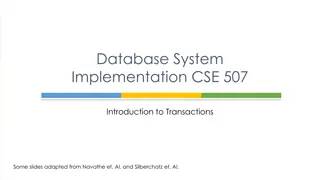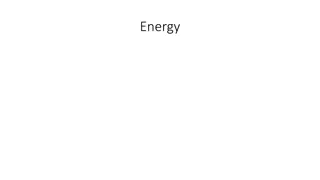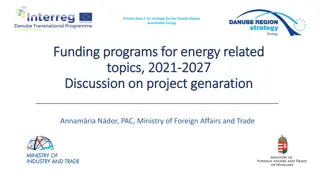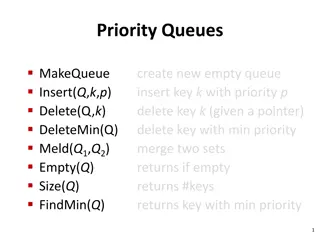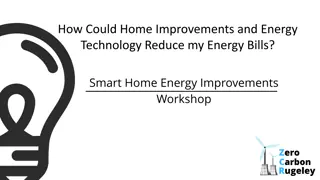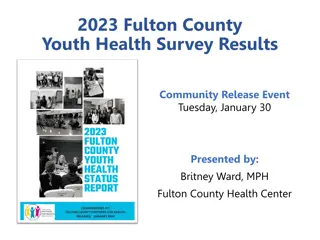High Priority Transaction Survey Results - Working Together for Sustainable Energy
Survey results from the Southwest Power Pool regarding high priority transactions outside of resource adequacy obligations. Participants believe in supporting commercial transactions meeting needs beyond WRAP-eligible capacity or RA obligations. Discussions include verifying committed supply, non-RA examples, registration requirements, and the importance of communication with market operators.
Download Presentation

Please find below an Image/Link to download the presentation.
The content on the website is provided AS IS for your information and personal use only. It may not be sold, licensed, or shared on other websites without obtaining consent from the author.If you encounter any issues during the download, it is possible that the publisher has removed the file from their server.
You are allowed to download the files provided on this website for personal or commercial use, subject to the condition that they are used lawfully. All files are the property of their respective owners.
The content on the website is provided AS IS for your information and personal use only. It may not be sold, licensed, or shared on other websites without obtaining consent from the author.
E N D
Presentation Transcript
HIGH PRIORITY TRANSACTION SURVEY RESULTS MSWG/MRATF 4/11/2024 Working together to responsibly and economically keep the lights on today and in the future. SPPorg southwest-power-pool 1 SouthwestPowerPool
DOES YOUR COMPANY BELIEVE THAT HIGH PRIORITY EXPORTS AND/OR HIGH PRIORITY IMPORTS SHOULD ENCOMPASS TRANSACTIONS THAT ARE OUTSIDE WRAP OR RESOURCE ADEQUACY OBLIGATIONS? Comments: We are not aware of any non-RA examples but are open to hearing discussion from others Yes, it is appropriate to support commercial transactions that meet needs other than for WRAP-eligible capacity or specific RA obligations. Any forward contracts should be eligible for high priority treatment. If high priority interchange is "backed by committed supply," why wouldn't transactions outside WRAP be included? Not all exports will be to WRAP participants Yes, if they are identified ahead of time and have a source committed to it Example: bi-lateral specified source sales that are not explicitly linked to an "RA plan It would depend on ability to verify the supply is committed to qualify as High priority import, this is relatively easy for imports sourcing from CAISO, but is currently undefined how committed supply would be verified for other import sourcing. For High Priority Export the definition in the Tariff already includes transactions that are not resource adequacy transactions by saying it includes source specific sales to load outside of the M+ footprint from the Resource s available surplus capacity I think the protocols should address how this type of export can be communicated to the market operator including how and who determines the Resource has available surplus capacity (is it only through WRAP Forward Showing or is there an alternative?). A market participant selling the High Priority Export would eventually be required to must-offer the capacity in day-ahead, but they may determine that it is economic to oversell and pay the must offer deficiency charge for the intervals where they don t actually have surplus. Yes, BPA has transactions outside WRAP and Resource Adequacy obligations that are firm power commitments to our counterparties and should count as high priority exports and/or high priority imports. Some, but not all, of the transactions are executed after the WRAP Forward Showing deadline, therefore, are not included in the WRAP or RA obligations. Would like to confirm that registered pseudo-tied loads and gen will be given the high priority status. 2 SPP Public Information
DOES YOUR COMPANY BELIEVE THAT HIGH PRIORITY EXPORTS AND/OR HIGH PRIORITY IMPORTS OTHER THAN THOSE IDENTIFIED TO SUPPORT WRAP NEED TO BE REGISTERED IN ADVANCE WITH MARKETS+ AND WOULD INCLUDE INFORMATION SUCH AS A CONTRACT WITH THE MARKETS+ MARKET PARTICIPANT SURPLUS SUPPLY, AN IDENTIFIED SOURCE (UNIT OR SYSTEM), APPROPRIATE TRANSMISSION SERVICE AND AN IMPLEMENTED ETAG? Comments: No, with proper controls in place it would be sufficient to require that information to be communicated in an e-tag submitted prior to the DAM run and/or the RTM (with potentially some additional controls for new RTM etags/schedules). Initially thinking is yes, but need more information on what this registration would look like. The market should allow for a method for participants to procure additional supply in the event of a resource trip or contingency. This should not require a registration ahead of M+ because these events are unknown. Additionally, the market design should ensure there is interoperability with the market design and the WRAP operations program between market participants inside Markets+ and those not in Markets+. No, the e-tag is the notification. needs more discussion, may possibly need an analysis on how burdensome this action would be. Yes, contracts should be registered in advance in order to receive high priority status. BPA would like to understand the registration timeline. 3 SPP Public Information
DOES YOUR COMPANY BELIEVE THAT HIGH PRIORITY EXPORTS AND/OR HIGH PRIORITY IMPORTS MUST BE SCHEDULED PRIOR TO DAY-AHEAD MARKET CLOSING, OTHERWISE THEY WOULD BE CONSIDERED UNCOMMITTED EXPORTS? Comments: Resources might be scheduled DA but not tagged until RT; request further discussion of what "scheduled" means No, however, if a resource not counted in the WRAP forward showing and not shown for the DA MOO is made available to RUC and is committed/scheduled in RUC, it should not be able to support a new RTM high-priority export; likewise, high-priority imports should be allowed after the DAM run to allow entities to "top off" their RTM MOO portfolio provided the requirements/controls are otherwise met. Initial thinking - as long as source is specified and other requirements are met it should be eligible for high priority. The market should allow for a method for participants to procure additional supply in the event of a resource trip or contingency. This should not require the transaction to be scheduled prior to day-ahead. Emergency power, supplemental power, etc should not be penalized if purchased during the real-time. Maybe, need more education on this one. Not sure. Would like to further discuss whether exports/imports that are scheduled after the DA market close without impacting footprint reliability (for an export, does it depend on whether that resource is called upon in RUC?) We are open to discussions of alternatives. There could be another option here where the contract/supply is verified but the scheduling can be optimized in the market, meaning that it doesn t need to be self- committed/scheduled to count. If they verify the contract/supply, they could also schedule in real-time and maintain the high priority classification. If the registration can serve as a mechanism to ensure high priority status, then no the transaction does not need to be tagged, consistent with the contract, prior to the day ahead market close. If not, then BPA wants only High Priority transactions that are tagged prior to the Day Ahead market close to be considered high priority exports and tags adjusted in RT should retain a high priority status. 4 SPP Public Information
DOES YOUR COMPANY BELIEVE THAT GENERATION SUPPORTED BY BALANCING AUTHORITY BALANCING SERVICES SUCH BPA S VERBS OR PSCO S SCHEDULE 16 WOULD MEAN THOSE EXPORTS ARE HIGH PRIORITY? Comments: Multiple responders requested the need for more information or further discussion or discussion of alternatives Yes, provided the other requirements are met and provided the BA providing the balancing services has accounted for that provision in their DA and/or RT MOO. Need to better understand this question - should not be a qualifying or disqualifying consideration on its own. Yes, by the definition of high priority and since those services guarantee regulation. Unclear what the connection is here between ancillary services and export status. Needs more discussion if this has to deal with balancing services they would deal with reliability. To ensure sufficient RA we would want the balancing services to be high priority. Unfamiliar with BPA and PSCO s products, but would tend to lean towards this as not being high priority and that it is settled in the applicable market appropriately, unless the contract passes the criteria for high priority export and are planned for in the resource adequacy program. Balancing Services from BPA is not the distinction that would classify it as a high priority export or not. Balancing Services ensures the BA can support schedules from all resources, but it is not the deciding factor of high priority export vs uncommitted export. High priority and uncommitted are market designations, potentially indicating impacts to the MOO and the actions the market operator will take in cases of market scarcity or overgeneration. If a customer taking balancing services from BPA can otherwise meet the high priority export requirements, the market should not cut these tags for general market scarcity solely. 5 SPP Public Information
DOES YOUR COMPANY BELIEVE THAT UNCOMMITTED IMPORTS OR EXPORTS SHOULD NOT BE PART OF A MARKET PARTICIPANT S NET POSITION AND WOULD THEREFORE NOT BE PART OF THE MUST-OFFER OBLIGATION? Comments: Multiple responders requested the need for further discussion or discussion of alternatives Yes, at the onset of the market - subject to change over time as M2M options are explored. Probably makes sense. Yes, for uncommitted exports. Not sure if a bright-line rule works for all uncommitted imports. If we go with not counting uncommitted in the must offer there needs to be something to prevent a market participant from selling outside the market for uncommitted import and exports, this sort of transaction should be cleared through the market software. Yes, uncommitted imports/exports should be excluded from the Net Position for purposes of the must offer. An example of uncommitted supply would be sellers choice contracts (seller has the option to change the source/unspecified). 6 SPP Public Information
DOES YOUR COMPANY HAVE ANY OTHER COMMENTS ON THIS TOPIC FOR SPP STAFF OR THE MSWG/MRATF TO CONSIDER? Comments: We believe it is important that high priority exports be included in an entity's must offer obligation and that they be fully arranged prior to the day ahead market run. This is necessary to protect the reliability of the Markets+ footprint. M+ has had to by default develop policy around high/low-priority interchange transactions in the context of CAISO's current policy and in expectation that that policy will be in place when M+ goes live. We are optimistic that better policy can be developed and implemented in a Market-to-Market negotiated future environment. Being able to transact "high priority" transfers in DA and RT is important as both an economic and environmental-attribute optimization perspective and to provide a replacement reserve or RT MOO compliance "top off" opportunity. While staying true to reliability and equitability principles, more flexibility should be sought over time in the requirements. We agree that both high priority exports "AND" imports should be treated on equal footing. We believe the tariff language stated imports "may" be included. Contingency reserves delivered to/from the footprint in respect to reserve sharing groups needs a place to be counted and communicated to the market software. Since contingency reserve deployment events are not planned, the market would need a mechanism to be made of aware when these BA to BA events occur and also the correct priority level. 7 SPP Public Information
ARE THERE ANY UNIQUE SCENARIOS WITH TAGGING IN YOUR AREA WHERE IF SCARCITY PRICING OR AN EXCESS GENERATION EVENT WERE TO OCCUR THAT YOU WOULDN T WANT AN UNCOMMITTED EXPORT OR IMPORT ADJUSTED BY THE MARKET OPERATOR RESPECTIVELY? (EXAMPLE MAY BE MANAGING BILATERAL CONTINGENCY RESERVE PURCHASES/SALES) Comments: Multiple responders requested the need for more information or further discussion SRP participates in DA and RT spinning reserve transactions. We would like to discuss how this might be impacted by the Market Operator adjusting uncommitted imports or exports. Unsure at this time - but we've assumed that RSG dispatch would span markets alongside WRAP and would need to be accounted for from an energy (and possibly from a transmission) perspective to ensure reliability dispatch can flow where needed and be held on resources that can deliver as expected. Yes, contingency reserves and other unique contracts. We agree that scarcity pricing should adjust uncommitted imports/exports, but there should be more discussion around the e-tagging protocols. Possibly. We would appreciate an opportunity for additional dialogue on the impacts to participants in scenarios where the market operator might adjust contingency reserves. If there is something in this category why don t we required it to be high priority and meet the criteria as such? Yes, any transaction that is providing operating reserves (e.g., regulating reserves and contingency reserves) should not be adjusted by the market operator. Two examples would be 1) tagging of self-supply of operating reserves and 2) deliveries of operating reserves to/from the reserve sharing group. In comment #1, if pseudo-tied loads and gen are not categorized as high priority status then BPA would like the market operator to not adjust these tags. 8 SPP Public Information







